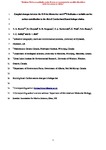Coupled changes between the H-Print biomarker and delta N-15 indicates a variable sea ice carbon contribution to the diet of Cumberland Sound beluga whales
| dc.contributor.author | Brown, TA | |
| dc.contributor.author | Chrystal, E | |
| dc.contributor.author | Ferguson, SH | |
| dc.contributor.author | Yurkowski, DJ | |
| dc.contributor.author | Watt, C | |
| dc.contributor.author | Hussey, NE | |
| dc.contributor.author | Kelley, TC | |
| dc.contributor.author | Belt, Simon | |
| dc.date.accessioned | 2017-07-26T16:05:38Z | |
| dc.date.issued | 2017-07 | |
| dc.identifier.issn | 0024-3590 | |
| dc.identifier.issn | 1939-5590 | |
| dc.identifier.uri | http://hdl.handle.net/10026.1/9643 | |
| dc.description.abstract |
<jats:title>Abstract</jats:title><jats:p>Sub‐Arctic habitats are being exposed to increasingly long periods of open water as sea ice continues to decline in thickness and extent. Some hypothesize that this will result in a reduction, and maybe total loss of sea ice derived (sympagic) carbon supply; however, the impact of such change on ecosystems requires further investigation. Here, we used the H‐Print biomarker approach that utilizes well‐defined indicators of both sympagic and phytoplanktic carbon, in combination with stable isotopes (δ<jats:sup>15</jats:sup>N), to study the effect of reducing sympagic carbon availability on beluga whales (<jats:italic>Delphinapterus leucas</jats:italic>) in the sub‐Arctic ecosystem of Cumberland Sound. Our data show that decreasing δ<jats:sup>15</jats:sup>N in belugas was negatively correlated with pelagic carbon (H‐Print) within their diet. We also identified a statistically significant (<jats:italic>R</jats:italic><jats:sup>2</jats:sup> = 0.82; <jats:italic>p</jats:italic> ≤ 0.01) change point in the proportion of sympagic/pelagic carbon within beluga around the year 2000, signified by consistently reducing δ<jats:sup>15</jats:sup>N, coupled with increasing pelagic carbon composition. This observed shift from sympagic to pelagic contribution to diet is likely to remain a feature of the Cumberland Sound ecosystem during the projected reduction of sea ice.</jats:p> | |
| dc.format.extent | 1606-1619 | |
| dc.language | en | |
| dc.language.iso | en | |
| dc.publisher | Wiley | |
| dc.subject | 13 Climate Action | |
| dc.title | Coupled changes between the H-Print biomarker and delta N-15 indicates a variable sea ice carbon contribution to the diet of Cumberland Sound beluga whales | |
| dc.type | journal-article | |
| dc.type | Journal Article | |
| plymouth.author-url | http://gateway.webofknowledge.com/gateway/Gateway.cgi?GWVersion=2&SrcApp=PARTNER_APP&SrcAuth=LinksAMR&KeyUT=WOS:000404993100020&DestLinkType=FullRecord&DestApp=ALL_WOS&UsrCustomerID=11bb513d99f797142bcfeffcc58ea008 | |
| plymouth.issue | 4 | |
| plymouth.volume | 62 | |
| plymouth.publication-status | Published | |
| plymouth.journal | LIMNOLOGY AND OCEANOGRAPHY | |
| dc.identifier.doi | 10.1002/lno.10520 | |
| plymouth.organisational-group | /Plymouth | |
| plymouth.organisational-group | /Plymouth/Faculty of Science and Engineering | |
| plymouth.organisational-group | /Plymouth/Faculty of Science and Engineering/School of Geography, Earth and Environmental Sciences | |
| plymouth.organisational-group | /Plymouth/REF 2021 Researchers by UoA | |
| plymouth.organisational-group | /Plymouth/REF 2021 Researchers by UoA/UoA07 Earth Systems and Environmental Sciences | |
| plymouth.organisational-group | /Plymouth/Research Groups | |
| plymouth.organisational-group | /Plymouth/Research Groups/Marine Institute | |
| plymouth.organisational-group | /Plymouth/Users by role | |
| plymouth.organisational-group | /Plymouth/Users by role/Academics | |
| plymouth.organisational-group | /Plymouth/Users by role/Researchers in ResearchFish submission | |
| dcterms.dateAccepted | 2017-01-05 | |
| dc.rights.embargodate | 2018-3-6 | |
| dc.identifier.eissn | 1939-5590 | |
| dc.rights.embargoperiod | 12 months | |
| rioxxterms.versionofrecord | 10.1002/lno.10520 | |
| rioxxterms.licenseref.uri | http://www.rioxx.net/licenses/under-embargo-all-rights-reserved | |
| rioxxterms.licenseref.startdate | 2017-07 | |
| rioxxterms.type | Journal Article/Review |


